For fans of Deep Time there are few things as exciting as an unconformity. An unconformity is a geologic contact separating rock masses of two different ages. Something in the rock record has gone missing or perhaps it was never there. It’s commonly expressed that an unconformity represents missing time. I’m no fan of that expression, just where did the time go :)?
As Sandy Denny sings on Fairport Convention’s album Unhalfbricking –
“Who knows where the time goes?”
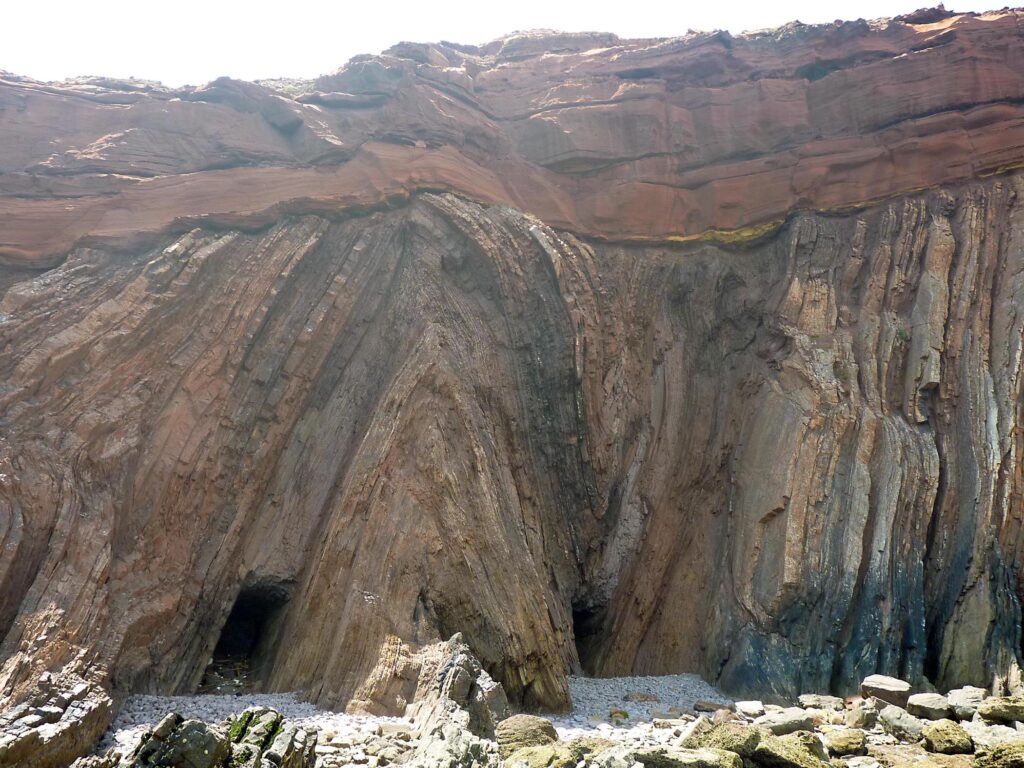
An angular unconformity nicely exposed in a seaside cliff at Telheiro, Portugal. Note the folded Pennsylvanian strata below the unconformity and gently dipping Triassic strata above the unconformity.Consider the geological record as a journal with each page recording an interval of time. With continuous sediment deposition, the record is continuously laid down one page at a time. But an unconformity is different as it’s an interruption of that process. Perhaps the journal’s author wrote 30 pages and then forgetfully skipped writing until page 63 – that’s a gap in the record from a lack of deposition. Another possibility is that the writing was continuous through time, but then after 85 pages of uninterrupted narrative someone comes along and rips 42 pages out of the book after which the writer commences journaling once more. In this analogy a significant amount of the geological record has been removed by erosion and is lost.
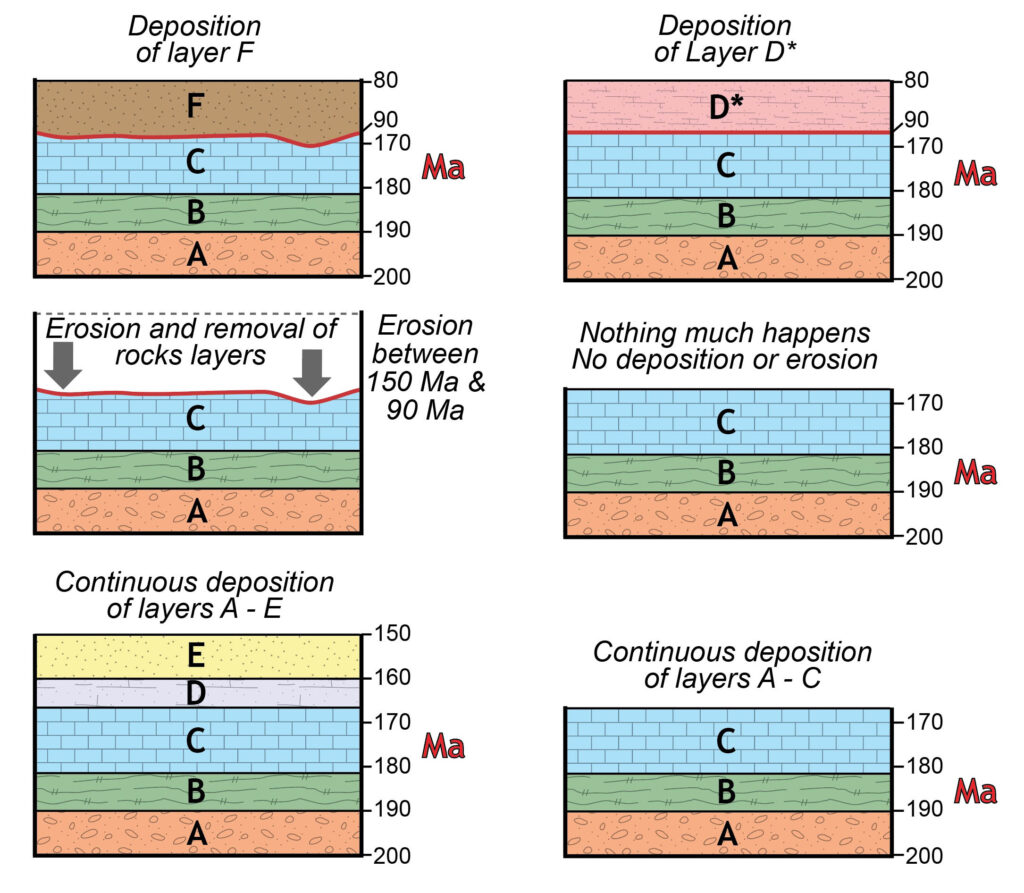
Simplified models for unconformities, the model on the left involves significant erosion before the deposition of Layer F above the unconformity. In the model on the right nothing much happens between 170 and 90 Ma when layer D* begins to be deposited. D and D* are not the same Layer.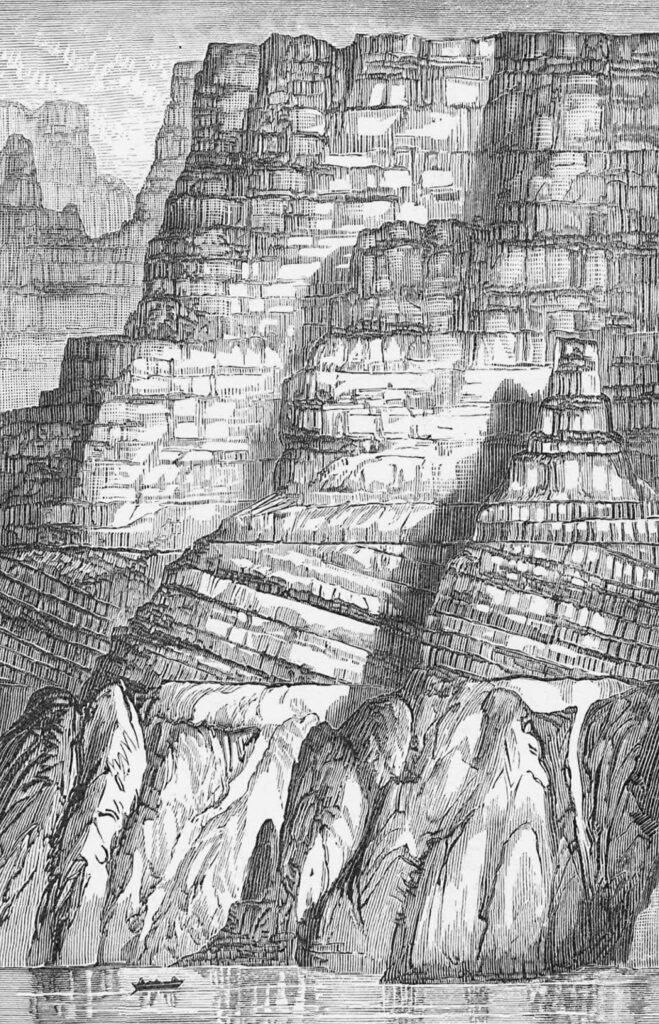
Line drawing of unconformities exposed in the walls of Arizona's Grand Canyon from Powell (1875).There are a few varieties of unconformities, including disconformities, nonconformities, paraconformities and angular unconformities. The geological record is full of unconformities; some are minor breaks while others of more significance. And then there’s the Great Unconformity.
In the mid 19th century, at Arizona’s Grand Canyon, John Wesley Powell first recognized a great unconformity and surmised its significance. This unconformity is exposed across the western United States, buried in the subsurface under the Midwest, and resurfaces in many parts of the Appalachians – it’s not a local feature rather it’s an important geological boundary that occurs on multiple continents.
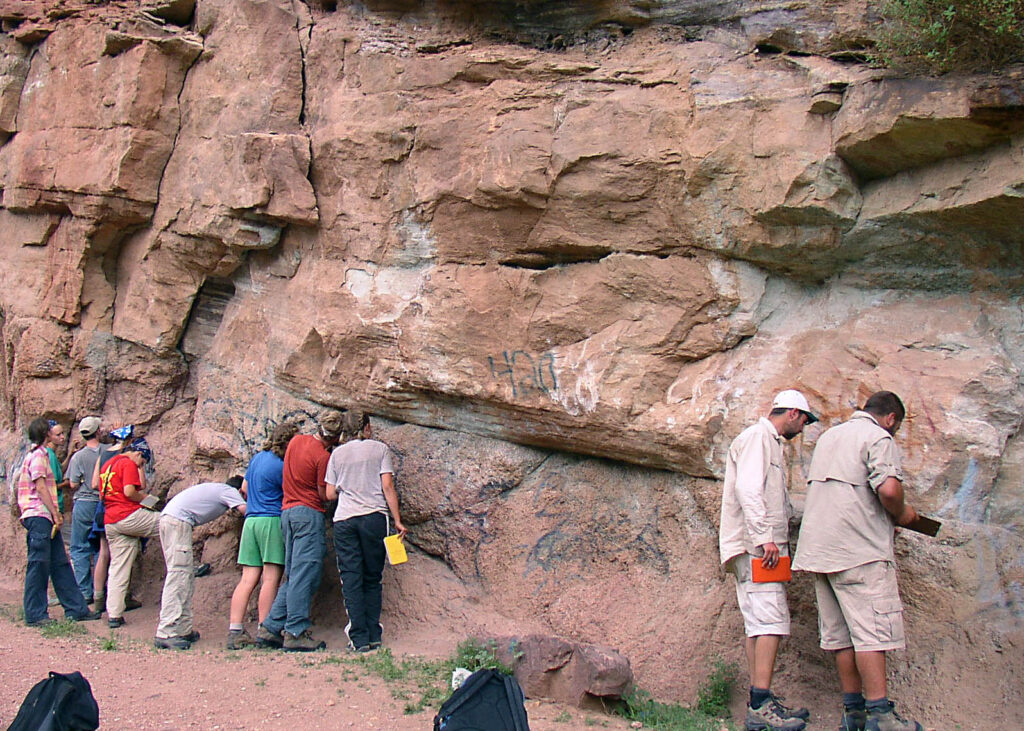
William & Mary geologists examining the Great Unconformity in the Rocky Mountains of Colorado (image from 2004).At many localities there was a tremendous amount of erosion ( >15 km) in the crustal rocks below the Great Unconformity which has been interpreted to be a more-or-less global event associated Snowball Earth during the Cyrogenian (720 – 635 Ma) – the idea being, extensive continent-wide glaciations removed prodigious amounts of crustal materials. However, not everybody (including me) buys into a causal link between a Snowball Earth and the Great Unconformity. It’s also clear that there are actually multiple Great Unconformities.
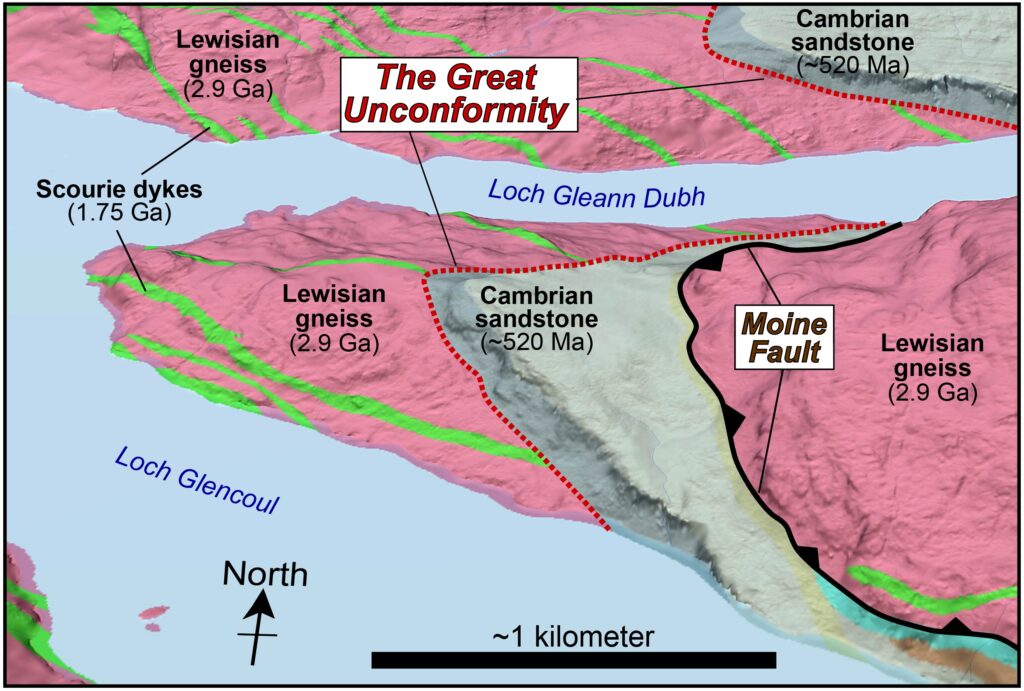
An oblique 3D digital view of the terrain, geology, and the Great Unconformity along Loch Glencoul and Gleann Dubh in the Scottish Highlands.The Great Unconformity lurks in Virginia’s Blue Ridge Mountains; here billion-year-old rocks of the basement complex are overlain by a cover sequence of 550 to 570 million-year-old metamorphosed sedimentary and volcanic rocks. The time gap across this contact is at least 500 million years and certainly qualifies as great in my mind.
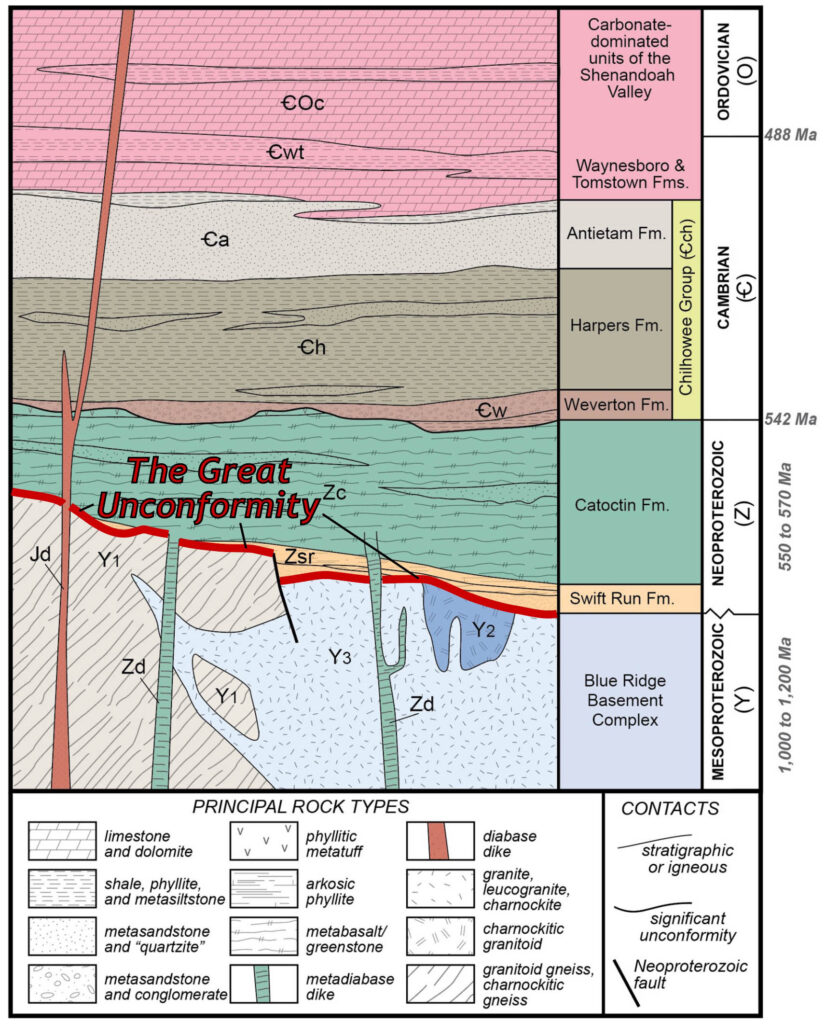
Generalized stratigraphy of the Blue Ridge Mountains in central/northern Virginia illustrating the Great Unconformity. From Bailey et al. (2025).This summer I’m collaborating with Mara Cox, a W&M Geology major, on a field-based research project to better understand the Great Unconformity in a small area of the Virginia Blue Ridge.
Our research questions include:
- What’s the geometry of the unconformity?
- What’s the age of the unconformity?
- What was the paleoclimate at the time the Great Unconformity formed?

Chasing the Great Unconformity on Crawford Knob, Mara Cox is in the back right.It’s August, so it’s stinky hot and humid in Virginia, plus the Blue Ridge is well vegetated at this time of year, thus locating the Great Unconformity takes effort and forbearance. We’ve gotten in some fieldwork, but much remains to be done. When the temperature and the vegetation dial it back going in the Fall, we’ll be back doing fieldwork.
The figure below is an oblique digital view of the terrain and the bedrock geology at Mara’s study area around Crawford Knob in Nelson County. The portrayed geology is based on Jerry Bartholomew’s wonderful 1977 map of the Sherando 7.5’ quadrangle, and the Great Unconformity arcs across this image. This image was generated from detailed LiDAR topographic data that shows way more detail than the old school maps which Jerry used when he mapped this area. I expect our mapping, informed by this imagery which show’s where the outcrops are located, will modify the existing geologic map in significant ways.
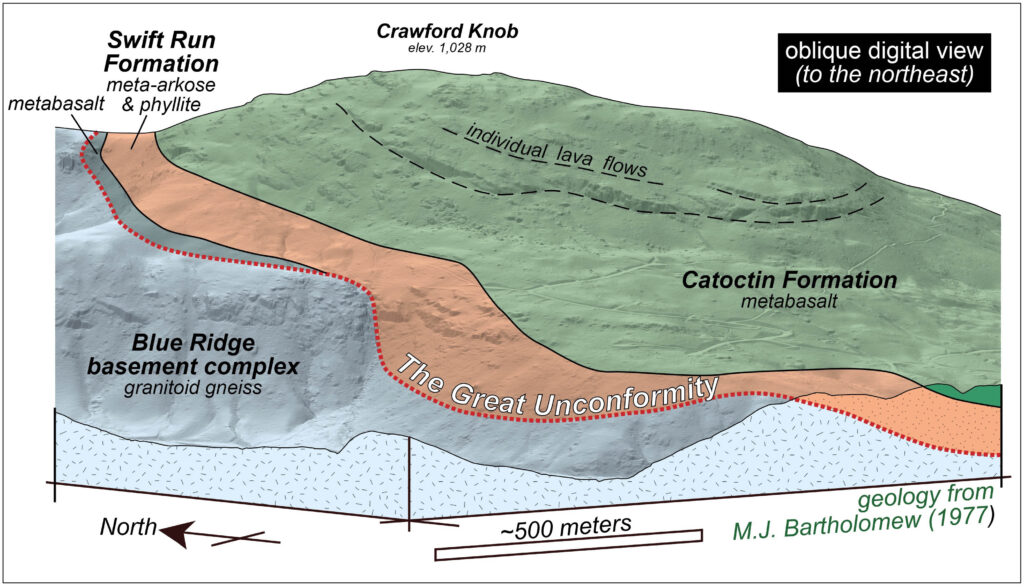
Oblique digital view of the landscape and terrain on Crawfords Knob, Virginia. Geology by M.J. Bartholomew (1977). Note the significant change in elevation of the Great Unconformity.In this small area, the elevation of the Great Unconformity changes considerably. This could be because the unconformity was originally not planar with lots of topographic relief (paleo high and lows), but it could be that later deformation distorted and folded the unconformity. Or it’s a combination of both original topographic relief on the unconformity and then later deformation – what a fun problem! That’s Mara’s job to elucidate and later this year she’ll fill us in on her findings.
Hello Professor Bailey, I am a student in your Tues/Thurs Physical Geography course. I wanted to leave a comment about my interest in your chosen study area of the Blue Ridge Mountains. I am from Harrisonburg, Virginia, so the Blue Ridge Mountains have always been a great point of interest for me. I am excited to follow your students updates and learn more about the updated mapping in this selected area. Thank you for sharing!